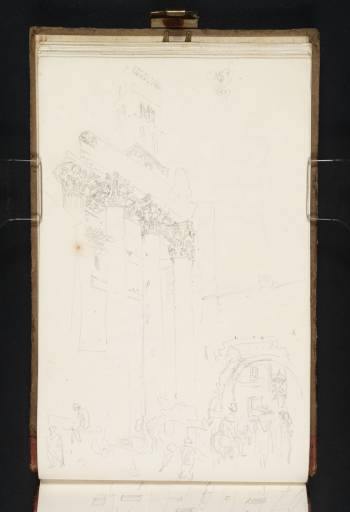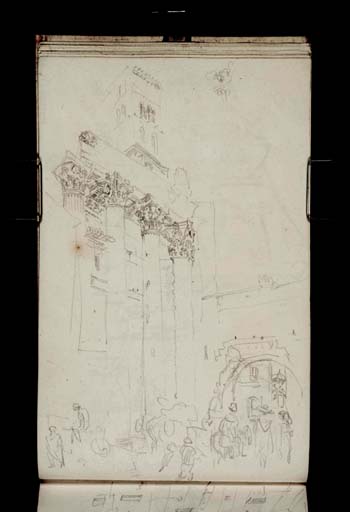Joseph Mallord William Turner The Temple of Mars Ultor and the Arco dei Pantani, Rome 1819
Image 1 of 2
Joseph Mallord William Turner,
The Temple of Mars Ultor and the Arco dei Pantani, Rome
1819
Joseph Mallord William Turner 1775–1851
Folio 14 Verso:
The Temple of Mars Ultor and the Arco dei Pantani, Rome 1819
D16184
Turner Bequest CLXXXVIII 14 a
Turner Bequest CLXXXVIII 14 a
Pencil on white wove paper, 189 x 114 mm
Accepted by the nation as part of the Turner Bequest 1856
References
1909
A.J. Finberg, A Complete Inventory of the Drawings of the Turner Bequest, London 1909, vol.I, p.558, as ‘Back of the Temple of Mars Ultor, with the Arco dei Pantani’.
1984
Cecilia Powell, ‘Turner on Classic Ground: His Visits to Central and Southern Italy and Related Paintings and Drawings’, unpublished Ph.D thesis, Courtauld Institute of Art, University of London 1984, p.111, reproduced fig.40, as ‘The Temple of Mars Ultor and the Arco dei Pantani’.
1987
Cecilia Powell, Turner in the South: Rome, Naples, Florence, New Haven and London 1987, p.38, reproduced p.37 pl.34, as ‘The Temple of Mars Ultor and the Arco dei Pantani’.
This sketch shows the Temple of Mars Ultor which stands in the Forum of Augustus to the east of the Roman Forum and the present-day Via dei Fori Imperiali. The colonnaded square was built to celebrate the victory of the Emperor Augustus at the Battle of Philippi in 41 BC over the assassins of Julius Caesar and was dominated by a temple dedicated to Mars the Avenger, the Roman god of war. Four marble Corinthian columns from the Temple still survive. In the nineteenth century these columns could be seen adjacent to the convent of Santa Maria Assunziata, the campanile of which is visible at the top of Turner’s sketch. The area was excavated during the 1930s and the convent was pulled down to expose the foundations of the temple underneath.
To the right of the Temple of Mars Ultor was one of two Roman triumphal arches built by the Emperor Tiberius in 19 AD and dedicated to his nephew Germanicus and his son Drusus. Owing to regular flooding in the area during the middle ages the arch on the south-east side of the Forum became known as the Arco dei Pantani (pantano in Italian means marsh or swamp). In front of the arch and the wall into which it is incorporated, Turner has drawn the busy throng of people going about their daily business. Cecilia Powell has cited this page as an example of Turner’s tendency to execute one part of a sketch in detail whilst leaving the rest loosely defined.1 He has also drawn an additional architectural detail at the top of the page, possibly part of one of the Corinthian capitals of the Temple.
Vistas of the Forum of Augustus from either side of the wall had been popular with artists since the seventeenth century. For views similar to Turner’s sketch see Piranesi’s etching, Veduta degli avanzi del Foro di Nerva, from volume I of Le antichità Romane, first published 1756,2 Guiseppe Vasi’s etching, Ruine del Foro di Nerva 1758, the view engraved by Luigi Rossini, in Viaggio Pittoresco da Roma a Napoli, 1839, a photographic albumen print by Edmondo Behles, Temple des Mars Ultor und Arco dei Pantani, 1865, and Rodolfo Lanciani's etching in Ancient Rome in the Light of Recent Discoveries, 1891.
Nicola Moorby
September 2008
How to cite
Nicola Moorby, ‘The Temple of Mars Ultor and the Arco dei Pantani, Rome 1819 by Joseph Mallord William Turner’, catalogue entry, September 2008, in David Blayney Brown (ed.), J.M.W. Turner: Sketchbooks, Drawings and Watercolours, Tate Research Publication, December 2012, https://www


